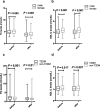Apolipoprotein E polymorphisms contribute to statin response in Chinese ASCVD patients with dyslipidemia
- PMID: 31153375
- PMCID: PMC6545221
- DOI: 10.1186/s12944-019-1069-5
Apolipoprotein E polymorphisms contribute to statin response in Chinese ASCVD patients with dyslipidemia
Abstract
Background: Apolipoprotein E (ApoE) plays an important role in lipid metabolism and clearance. Statins are the most common drugs used to modulate the lipid profile in the clinic therapy; the associations between ApoE polymorphisms and statin response to lipids were inconsistent in previous studies among different ethnicities. Our study aimed to demonstrate the relationships among the statins response and the ApoE gene common polymorphisms and lifestyle risk factors in Chinese arteriosclerotic cardiovascular disease (ASCVD) patients with dyslipidemia.
Methods: A total of 1002 dyslipidemia ASCVD patients were recruited in this study, including 311 patients with a history of type 2 diabetes mellitus (T2DM). These patients were all treated with drugs atorvastatin (10 mg/d) or rosuvastatin (5 mg/d) for at least 4 weeks and genotyped for ApoE e2/e3/e4 alleles, using Kompetitive Allele Specific PCR (KASP) and Sanger sequencing. The plasma lipids levels were determined before and after statins treatment.
Results: The results of ApoE genotyping with KASP method were consistent with the sequencing analysis. In the total 1002 patients, the E2 phenotypes (e2/e3, e2/e2) had significant lower low-density lipoprotein cholesterol (LDL-C) baseline levels than subjects with E3 (e3/e3, e2/e4) and E4 (e3/e4, e4/e4) phenotypes (P = 0.007, 0.005, respectively), and E2 phenotypes had the highest triglyceride (TG) baseline levels. To statins treatment, E2 phenotypes had a better response in TG, Total cholesterol (TC) and LDL-C reduction percentage compared with other phenotypes, and smoking/alcohol drinking status also had a significant influence on statins response of LDL-C lowering. No significant difference was found in the effects of lipids decreasing between atorvastatin and rosuvastatin drugs in all patients.
Conclusions: We developed the KASP technique for the ApoE genotyping, and demonstrated ApoE polymorphisms interacted with smoking/drinking to influence the declining extent of TG, TC and LDL-C levels after statins therapy in Chinese dyslipidemia ASCVD patients. These discoveries developed our cognition with the genetic polymorphisms effects on statin response, which should be taken more seriously in smoking/drinking E4 amino acid isoform carriers.
Keywords: Apolipoprotein E; KASP; Polymorphism; Statins response.
Conflict of interest statement
The authors declared no competing interests.
Figures






Similar articles
-
[Influence of ApoE gene polymorphisms on therapeutic effects of lipid-lowering statins among patients with ischemic cerebral infarction].Zhonghua Yi Xue Yi Chuan Xue Za Zhi. 2022 Jan 10;39(1):94-98. doi: 10.3760/cma.j.cn511374-20201104-00775. Zhonghua Yi Xue Yi Chuan Xue Za Zhi. 2022. PMID: 34964977 Chinese.
-
[Relationship between gene polymorphism at the apolipoprotein E locus and serum lipid profile in urban children of school age in Beijing].Zhonghua Yu Fang Yi Xue Za Zhi. 2001 Sep;35(5):297-300. Zhonghua Yu Fang Yi Xue Za Zhi. 2001. PMID: 11769625 Chinese.
-
Polymorphisms in apolipoprotein E and apolipoprotein A-V do not influence the lipid response to rosuvastatin but are associated with baseline lipid levels in Chinese patients with hyperlipidemia.J Clin Lipidol. 2012 Nov-Dec;6(6):585-92. doi: 10.1016/j.jacl.2012.02.005. Epub 2012 Feb 18. J Clin Lipidol. 2012. PMID: 23312054
-
Pitavastatin: novel effects on lipid parameters.Atheroscler Suppl. 2011 Nov;12(3):277-84. doi: 10.1016/S1567-5688(11)70887-X. Atheroscler Suppl. 2011. PMID: 22152282 Review.
-
APO E gene and gene-environment effects on plasma lipoprotein-lipid levels.Physiol Genomics. 2000 Dec 18;4(2):101-108. doi: 10.1152/physiolgenomics.2000.4.2.101. Physiol Genomics. 2000. PMID: 11120871 Review.
Cited by
-
Sex and APOE genotype differences related to statin use in the aging population.Alzheimers Dement (N Y). 2021 May 2;7(1):e12156. doi: 10.1002/trc2.12156. eCollection 2021. Alzheimers Dement (N Y). 2021. PMID: 33969178 Free PMC article.
-
Effects of Statin Therapy on Glycemic Control and Associated Factors Among Type 2 Diabetes Mellitus Patients in Northeastern Tanzania: A Retrospective Cohort Study.J Diabetes Res. 2025 Aug 1;2025:6626154. doi: 10.1155/jdr/6626154. eCollection 2025. J Diabetes Res. 2025. PMID: 40785972 Free PMC article.
-
Screening for variable drug responses using human iPSC cohorts.PLoS One. 2025 May 30;20(5):e0323953. doi: 10.1371/journal.pone.0323953. eCollection 2025. PLoS One. 2025. PMID: 40445916 Free PMC article.
-
Apolipoprotein E Gene Polymorphism and Coronary Artery Disease Risk Among Patients in Northwest China.Pharmgenomics Pers Med. 2021 Dec 7;14:1591-1599. doi: 10.2147/PGPM.S338285. eCollection 2021. Pharmgenomics Pers Med. 2021. PMID: 34908864 Free PMC article.
-
Alcohol Drinking, Apolipoprotein Polymorphisms and the Risk of Cardiovascular Diseases.Curr Neurovasc Res. 2021;18(1):150-161. doi: 10.2174/1567202618666210406123503. Curr Neurovasc Res. 2021. PMID: 33823779 Free PMC article. Review.
References
-
- Lahoz C, Peña R, Mostaza JM, et al. Baseline levels of low-density lipoprotein cholesterol and lipoprotein (a) and the AvaII polymorphism of the low-density lipoprotein receptor gene influence the response of low-density lipoprotein cholesterol to pravastatin treatment. Metabolism. 2005;54(6):741–747. doi: 10.1016/j.metabol.2004.12.020. - DOI - PubMed
MeSH terms
Substances
Grants and funding
LinkOut - more resources
Full Text Sources
Miscellaneous

